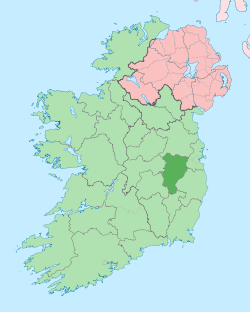River Barrow
| River Barrow (An Bhearú) | |
| River | |
 River Barrow at Muine Bheag, County Carlow | |
| Country | Ireland |
|---|---|
| Counties | Laois, Kildare, Kilkenny, Carlow, Wexford, Waterford |
| Part of | Three Sisters |
| Tributaries | |
| - right | River Nore, River Suir |
| Source | Slieve Bloom Mountains |
| - location | Glenbarrow, Laois |
| - elevation | 350 m (1,148 ft) |
| Mouth | Celtic Sea |
| - location | Waterford Harbour, Waterford |
| Length | 192 km (119 mi) |
| Area | 3,067 km2 (1,184 sq mi) |
| Discharge | |
| - average | 37.4 m3/s (1,321 cu ft/s) |
The Barrow (Irish: An Bhearú) is a river in Ireland. It is one of The Three Sisters; the other two being the River Suir and the River Nore. The Barrow is the longest of the three rivers. At 192 km (120 mi), it is the second-longest river in Ireland, behind the River Shannon. The catchment area of the River Barrow is 3,067 km2.[1] The river's long term average flow rate is 37.4 cubic metres per second.[2]
The source of the River Barrow is at Glenbarrow in the Slieve Bloom Mountains in County Laois.
Among the towns that the River Barrow passes through on its way to the sea in Waterford are Portarlington, Monasterevin, Athy, Carlow/Graiguecullen, Muine Bheag ( i.e. Bagenalstown,) Graiguenamanagh, and New Ross.
The river also forms a natural border between, on its right bank, counties Kilkenny and Waterford and, on its left bank, counties Carlow and Wexford.
History
The river's name is attributed to the action of Dian Cecht when he slew three serpents found in the heart of The Morrígan's infant son and threw them into the Barrow, thus causing it to boil.[3] The earliest recorded name for the river is Berbha, from an AD 996 entry in the Annals of the Four Masters.
- Sloighedh la Domhnall ua Néill co Laighnibh co ros-indir o Bherbha siar go fairrge, & do-bert bóromha mhór lais, & do-rad forbhais for Ghallaibh, & for Laighnibh co cenn da mhíos. As don chur-sin torchair Fionn, mac Goirmghiolla, Dunghal mac Dúnghaile I Riagáin, & Ronán, mac Bruadair, mic Duibhgiolla, & aroile saor-chlanna do Laighnibh amaille friu.[4]
Translated:
- An army was led by Domnall ua Néill into Leinster; and he plundered from the Berbha eastwards to the sea; and he carried off a great prey of cattle; and he laid siege to the Norsemen and the Leinstermen for two months. On this occasion were slain Fionn, son of Goirmghilla; Dunghal, son of Dunghal Ua Riagain; Ronan, son of Bruadar, son of Duibhghilla, and other nobles of the Leinstermen along with them.
The name Berbha is believed to derive from the Proto-Celtic *boru- ("boil", "bubble"), and is associated with Borvo, the Celtic god of minerals and spring water. Later spellings include Berba, Birga, Baruwe and Berrowe.[5]
The Barrow historically provided a natural boundary between the kingdoms of Laigin on the eastern shore and Osraige on the western shore.
There was a proverb quoted by Sir John Davies that “whoso lives by west of the Barrow, lives west of the law.”[6]
Barrow Navigation
The River Barrow forms a major part of Ireland's inland waterways network, providing an inland link between the port of Waterford and the Grand Canal, which in turn connects Dublin to the River Shannon. There are three sections to the navigation:
- The tidal River Barrow, which together with the tidal reaches of its tributaries the River Suir and River Nore constitute 88 km (55 miles) of tidal river navigation.
- The non-tidal river navigation featuring 23 locks, continuing 66 km (41 miles) inland from the tidal limit of the Barrow at St Mullin's to Athy.
- The Barrow Line of the Grand Canal connects to the river at Athy and continues northwards a further 45 km (28 miles) with 9 locks, connecting to the mainline of the Grand Canal at Lowtown.
See also
References
- ↑ South Eastern River Basin District Management System. Page 38
- ↑ South Eastern River Basin District Management System. Page 38
- ↑ https://www.academia.edu/10246879/Indo-European_Dragon-Slayers_and_Healers_and_the_Irish_Account_of_Dian_C%C3%A9cht_and_M%C3%A9iche
- ↑
- ↑
- ↑ Falkiner, Caesar Litton (1904). Illustrations of Irish history and topography, mainly of the seventeenth century. London: Longmans, Green, & Co. p. 117. ISBN 1-144-76601-X.
External links
| Wikimedia Commons has media related to River Barrow. |
Coordinates: 52°14′N 6°58′W / 52.233°N 6.967°W
